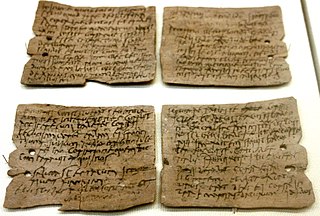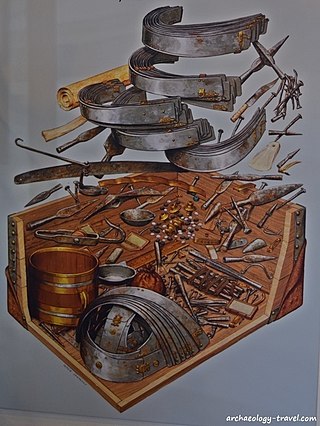
Vindolanda was a Roman auxiliary fort (castrum) just south of Hadrian's Wall in northern England, which it pre-dated. Archaeological excavations of the site show it was under Roman occupation from roughly 85 AD to 370 AD. Located near the modern village of Bardon Mill in Northumberland, it guarded the Stanegate, the Roman road from the River Tyne to the Solway Firth. It is noted for the Vindolanda tablets, a set of wooden leaf-tablets that were, at the time of their discovery, the oldest surviving handwritten documents in Britain.

Verulamium was a town in Roman Britain. It was sited southwest of the modern city of St Albans in Hertfordshire, England. A large portion of the Roman city remains unexcavated, being now park and agricultural land, although due to ploughing on the privately owned agricultural half of the city a lot of damage has been done, as proven by parts of mosaic floors that have been found on the surface, and results of ground penetrating radar show outlines of buildings as smudges rather than clearly defined walls like those protected by the parkland. Part of the Roman city has been built upon, such as St Michael's church and other parts along the centre of the medieval village. The major ancient Roman route Watling Street passed through the city. Much of the site and its environs is now a scheduled monument.

The London Mithraeum, also known as the Temple of Mithras, Walbrook, is a Roman Mithraeum that was discovered in Walbrook, a street in the City of London, during a building's construction in 1954. The entire site was relocated to permit continued construction and this temple of the mystery god Mithras became perhaps the most famous 20th-century Roman discovery in London.

MOLA is an archaeology and built heritage practice and independent charitable company registered with the Chartered Institute for Archaeologists (CIfA), providing a wide range of professional archaeological services to clients in London and across the country. It is one of the largest archaeological service providers in the UK, and is the only one with IRO status.

Roman cursive is a form of handwriting used in ancient Rome and to some extent into the Middle Ages. It is customarily divided into old cursive and new cursive.

A wax tablet is a tablet made of wood and covered with a layer of wax, often linked loosely to a cover tablet, as a "double-leaved" diptych. It was used as a reusable and portable writing surface in antiquity and throughout the Middle Ages. Cicero's letters make passing reference to the use of cerae, and some examples of wax-tablets have been preserved in waterlogged deposits in the Roman fort at Vindolanda on Hadrian's Wall. Medieval wax tablet books are on display in several European museums.

Piercebridge Roman Fort is a scheduled ancient monument situated in the village of Piercebridge on the banks of the River Tees in modern-day County Durham, England. There were Romans here from about AD 70 until at least the early 5th century. There was an associated vicus and bath house at Piercebridge, and another vicus and a villa south of the river at Cliffe. The Victorians used carved stones from this site when they built St Mary's church at Gainford. Part of the site is under Piercebridge village green.

The Vindolanda tablets were, at the time of their discovery, the oldest surviving handwritten documents in Britain. They are a rich source of information about life on the northern frontier of Roman Britain. Written on fragments of thin, postcard-sized wooden leaf-tablets with carbon-based ink, the tablets date to the 1st and 2nd centuries AD. Although similar records on papyrus were known from elsewhere in the Roman Empire, wooden tablets with ink text had not been recovered until 1973, when archaeologist Robin Birley, his attention being drawn by student excavator Keith Liddell, discovered some at the site of Vindolanda, a Roman fort in northern England.
Luguvalium was an ancient Roman city in northern Britain located within present-day Carlisle, Cumbria, and may have been the capital of the 4th-century province of Valentia. It was the northernmost city of the Roman Empire.
Robin Edgar Birley was a British archaeologist. He was the Director of Excavations at the Roman site of Vindolanda and head of the Vindolanda research committee. He was the son of Eric Birley and Margaret "Peggy" Birley and brother of Anthony Birley. His wife Patricia Birley, son Andrew Birley, and daughter-in-law Barbara Birley are also published authors on Roman Vindolanda.

The Corbridge Hoard is a hoard of mostly iron artefacts that was excavated in 1964 within the Roman site of Coria, next to what is now Corbridge, Northumberland, England.

Bremetennacum,, or Bremetennacum Veteranorum, was a Roman fort on the site of the present day village of Ribchester in Lancashire, England. The site is a Scheduled Monument.

Uxelodunum was a Roman fort with associated civilian settlement (vicus) in modern-day Carlisle, Cumbria, England. It was the largest fort on Hadrian's Wall and is now buried beneath the suburb of Stanwix.
Sulpicia Lepidina was the wife of Flavius Cerialis, prefect of the Ninth Cohort of Batavians, stationed at Vindolanda in Roman Britain in the early 2nd century AD. She is known from her correspondence, including a birthday invitation she received from Claudia Severa.

The Bath curse tablets are a collection of about 130 Roman era curse tablets discovered in 1979/1980 in the English city of Bath. The tablets were requests for intervention of the goddess Sulis Minerva in the return of stolen goods and to curse the perpetrators of the thefts. Inscribed mostly in British Latin, they have been used to attest to the everyday spoken vernacular of the Romano-British population of the second to fourth centuries AD. They have also been recognised by UNESCO in its Memory of the World UK Register.

The Stage in Shoreditch is a new mixed-use development from London property developer Galliard Homes, Cain Hoy, McCourt Global, Vanke and The Estate Office Shoreditch. The development is set to include a 37-storey residential tower, over 250,000 sq. ft. of office, retail and leisure space as well as incorporating a world heritage centre on the site of Shakespeare's Curtain Theatre. Centred on the theatre, the development will also feature over an acre of public space including a performance area and a park.

Bloomberg London is an office building in the City of London, which was opened in 2017. It is owned by Bloomberg L.P. and functions as their European headquarters. It is at 3 Queen Victoria Street, to the west of Walbrook, on the site previously occupied by Bucklersbury House.
Roger Simon Ouin Tomlin is a British archaeologist specialising in the translation of Latin text and epigraphy. Tomlin is an Emeritus Fellow of Wolfson College, Oxford.

The Mithraeum of Dura Europos was found during excavations in the city in 1934. It is considered to be one of the best-preserved and best-documented cult buildings of Mithraism.
















